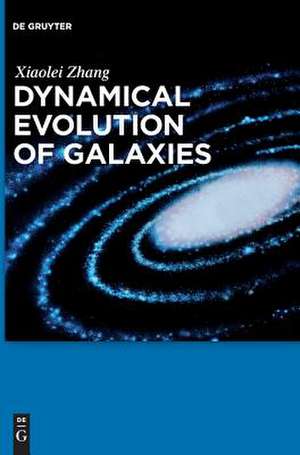Dynamical Evolution of Galaxies
Autor Xiaolei Zhangen Limba Engleză Hardback – 4 dec 2017
Contents
Dynamical Drivers of Galaxy Evolution
N-Body Simulations of Galaxy Evolution
Astrophysical Implications of the Dynamical Theory
Putting It All Together
Concluding Remarks
Appendix: Relation to Kinetics and Fluid Mechanics
Preț: 1097.31 lei
Preț vechi: 1425.08 lei
-23% Nou
Puncte Express: 1646
Preț estimativ în valută:
209.99€ • 217.99$ • 175.10£
209.99€ • 217.99$ • 175.10£
Carte tipărită la comandă
Livrare economică 22 martie-05 aprilie
Preluare comenzi: 021 569.72.76
Specificații
ISBN-13: 9783110525199
ISBN-10: 3110525194
Pagini: 338
Ilustrații: 250 Schwarz-Weiß- und 10 farbige Abbildungen, 20 Schwarz-Weiß- Tabellen
Dimensiuni: 175 x 246 x 24 mm
Greutate: 0.75 kg
Editura: De Gruyter
ISBN-10: 3110525194
Pagini: 338
Ilustrații: 250 Schwarz-Weiß- und 10 farbige Abbildungen, 20 Schwarz-Weiß- Tabellen
Dimensiuni: 175 x 246 x 24 mm
Greutate: 0.75 kg
Editura: De Gruyter
Cuprins
Content
Preface page 1 Introduction 1.1 Observational Background 1.2 Theoretical Background 1.3 Organization of the Material
2 Drivers of Secular Morphological Evolution of Galaxies 2.1 Motivations for the Theoretical Approach 2.2 Density Wave Crest as the Site of Gravitational Instability 2.3 Potential-Density Phase Shifts for Density Wave Modes 2.4 Linear Regime and Quasi-Steady State of the Wave Modes 2.5 Torque Coupling and Angular Momentum Transport 2.6 Rates of Secular Evolution 2.7 Relation to "Broadening of Resonances” 2.8 In a Nutshell
3 Verification of Analytical Results through N-Body Simulations 3.1 Overview of the N-Body Simulations of Disk Galaxies 3.2 Simulation Codes and Basic State Specifications 3.3 Signature of Collisionless Shock in N-Body Spirals 3.4 Modal Nature of a Spontaneously-Formed Pattern 3.5 Qualitative Signature of Secular Mass Redistribution 3.6 Longevity of the Spiral Modes 3.7 Role of Gas 3.8 Implication on Orbits as "Building Blocks” 3.9 Second Generation Tests
4 Astrophysical Implications of the New Dynamical Theory 4.1 Motivations and General Outline 4.2 Potential-Density Phase Shift (PDPS) Method for CR Determination 4.3 Secular Mass Migration and Bulge Building 4.4 Secular Heating and The Age-Velocity-Dispersion Relation 4.5 Secular Heating and the Size-Linewidth Relation 4.6 Other Characteristics of the Milky Way Galaxy and External Galaxies 4.7 Universal Rotation Curve 4.8 Secular Evolution and the Maintenance of Galaxy Scaling Relations 4.9 Butcher-Oemler Effect and Evolution of Cluster Galaxies 4.10 Secular Evolution and the Origin of Color-Magnitude Relation 4.11 An Example of Secular Evolution in Interacting Galaxies 4.12 Black-Hole-Mass and Bulge-Mass Correlation
5 Putting in All Together: What We Have Learned So Far 5.1 Reexamine the Foundations 5.2 Role of Basic State Specification 5.3 Broader Implications 5.4 Implications on the Cosmological Evolution of Galaxies
6 Concluding Remarks
7 Appendix. Nonequilibrium Phase Transition and Classical Mechanics 7.1 Foundation of Kinetic Theory: the Boltzmann Equation 7.2 From Kinetic Theory to Fluid Mechanics 7.3 Nonequilibrium Phase Transition and Galaxy Evolution 7.4 The Proper Choice of Hierarchies
8 References
Preface page 1 Introduction 1.1 Observational Background 1.2 Theoretical Background 1.3 Organization of the Material
2 Drivers of Secular Morphological Evolution of Galaxies 2.1 Motivations for the Theoretical Approach 2.2 Density Wave Crest as the Site of Gravitational Instability 2.3 Potential-Density Phase Shifts for Density Wave Modes 2.4 Linear Regime and Quasi-Steady State of the Wave Modes 2.5 Torque Coupling and Angular Momentum Transport 2.6 Rates of Secular Evolution 2.7 Relation to "Broadening of Resonances” 2.8 In a Nutshell
3 Verification of Analytical Results through N-Body Simulations 3.1 Overview of the N-Body Simulations of Disk Galaxies 3.2 Simulation Codes and Basic State Specifications 3.3 Signature of Collisionless Shock in N-Body Spirals 3.4 Modal Nature of a Spontaneously-Formed Pattern 3.5 Qualitative Signature of Secular Mass Redistribution 3.6 Longevity of the Spiral Modes 3.7 Role of Gas 3.8 Implication on Orbits as "Building Blocks” 3.9 Second Generation Tests
4 Astrophysical Implications of the New Dynamical Theory 4.1 Motivations and General Outline 4.2 Potential-Density Phase Shift (PDPS) Method for CR Determination 4.3 Secular Mass Migration and Bulge Building 4.4 Secular Heating and The Age-Velocity-Dispersion Relation 4.5 Secular Heating and the Size-Linewidth Relation 4.6 Other Characteristics of the Milky Way Galaxy and External Galaxies 4.7 Universal Rotation Curve 4.8 Secular Evolution and the Maintenance of Galaxy Scaling Relations 4.9 Butcher-Oemler Effect and Evolution of Cluster Galaxies 4.10 Secular Evolution and the Origin of Color-Magnitude Relation 4.11 An Example of Secular Evolution in Interacting Galaxies 4.12 Black-Hole-Mass and Bulge-Mass Correlation
5 Putting in All Together: What We Have Learned So Far 5.1 Reexamine the Foundations 5.2 Role of Basic State Specification 5.3 Broader Implications 5.4 Implications on the Cosmological Evolution of Galaxies
6 Concluding Remarks
7 Appendix. Nonequilibrium Phase Transition and Classical Mechanics 7.1 Foundation of Kinetic Theory: the Boltzmann Equation 7.2 From Kinetic Theory to Fluid Mechanics 7.3 Nonequilibrium Phase Transition and Galaxy Evolution 7.4 The Proper Choice of Hierarchies
8 References
Notă biografică
Xiaolei Zhang, George Mason University, USA
